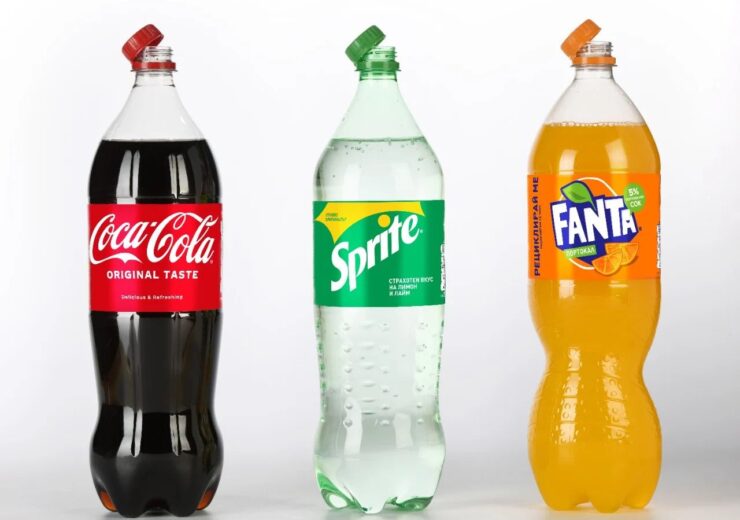Production will start in February and over 275 million bottles with attached caps rolling out on all soft drink brands in Bulgaria in 2023

The new caps will make it easier to recycle the whole beverage package and are aimed to ensure more plastic bottles are collected with their caps attached. (Credit: Coca-Cola HBC)
Marking another step forward towards Coca-Cola’s vision for a World Without Waste, Coca-Cola System in Bulgaria will introduce “tethered” – or attached – caps on plastic bottles for all soft drink brands in Bulgaria to consumers starting in February 2023.
Part of Coca-Cola’s ongoing transition across Europe to meet the provisions on closures of plastic beverage containers in the EU Directive on Single-use Plastics, this move is intended to boost the collection and recycling of plastic caps and bottles – to help reduce packaging litter. The new cap design is another milestone on Coca-Cola’s sustainable packaging journey – marked by a global commitment to collect and recycle a bottle or can for each one it sells by 2030, and to go further, faster, where it can, to eliminate packaging litter.
Starting in February, production of the new attached cap design will begin across the portfolio of Coca-Cola System in Bulgaria soft drinks brands, and the change will be implemented gradually in the first half of 2023. Bottles with the new cap feature will be made at the Kostinbrod production line after at the beginning of 2022 the company’s production line in Bankya introduced the innovation for the first time in Bulgaria.
Coca-Cola’s tethered closures solution is an innovative design that marks an important milestone in its ongoing innovation roadmap. The introduction of the attached cap is a fairly complex process that could have a great impact. The opening system is the same as the standard bottle. The innovation is applied through a ring that, using a simple tab, makes the cap fit perfectly. The cap stays connected to the security ring on the bottle and the tab ensures a perfect opened position.
“The Coca-Cola System shares the EU’s commitment to promoting and improving the collection and recycling of packaging waste. Our goal is to help eliminate plastic waste by continuing to look for and offer the most sustainable ways for people to enjoy our drinks,” shares Juerg Burkhalter, general manager of Coca-Cola HBC Bulgaria, and adds: “The design of the attached cap is the result of our ongoing commitment to sustainable packaging innovation and extensive collaboration with our partners. We started the transition to attached caps last year with the introduction of the new Bankya mineral water attached cap bottles and more than ever we see the change as an opportunity to encourage recycling, supporting our aim for 100% bottle and cap collection.”
The Coca-Cola System in Bulgaria continues to report results and prove that its mission for a World Without Waste is achievable. The report on Sustainable Development of the System in our country for 2020-2021 shows that one hundred percent of the packaging of all Coca-Cola products is now recyclable. Additionally, thanks to the lightening of the bottles of its products in 2021, the company has saved over 1150 tons of plastic, which is equivalent to over 58 million bottles of Coca-Cola 0.500 ml. All the materials saved have helped significantly to prevent more than 2,500 tons of carbon emissions from being released into the atmosphere. The Coca-Cola system in Bulgaria also reported early fulfillment of one of its key goals until 2025, namely a reduction of direct carbon emissions by 30%, saving a total of over 90,483 tons of emissions from its overall activity in the country for the period of 2020-2021.
A great deal of research and development, design collaboration with suppliers, and consumer testing have gone into developing the new attached cap solution.
The closures are tested at Coca-Cola’s R&D packaging lab in Brussels to ensure that they not only deliver a comfortable experience for consumers and offer practical, hygiene-related, and functional benefits, but also meet the regulation’s requirements and the highest technical and safety standards. The cap design is also designed to facilitate the collection and recycling of the packaging. Extensive consumer research and testing done earlier this year across Europe helped define and develop a preferred consumer solution accompanied by clear consumer communications about the new cap.
The transition to facilitated recycling is supported by the clear message on the packaging label, as well as through a message on neck hanger attached to the neck of the bottle: “Keep the cap attached for easier collecting and recycling”, and on-cap guidelines on how to use the new cap – ”Open, bend back, drink, reseal” and through in-store, TV and online consumer marketing.
Source: Company Press Release
